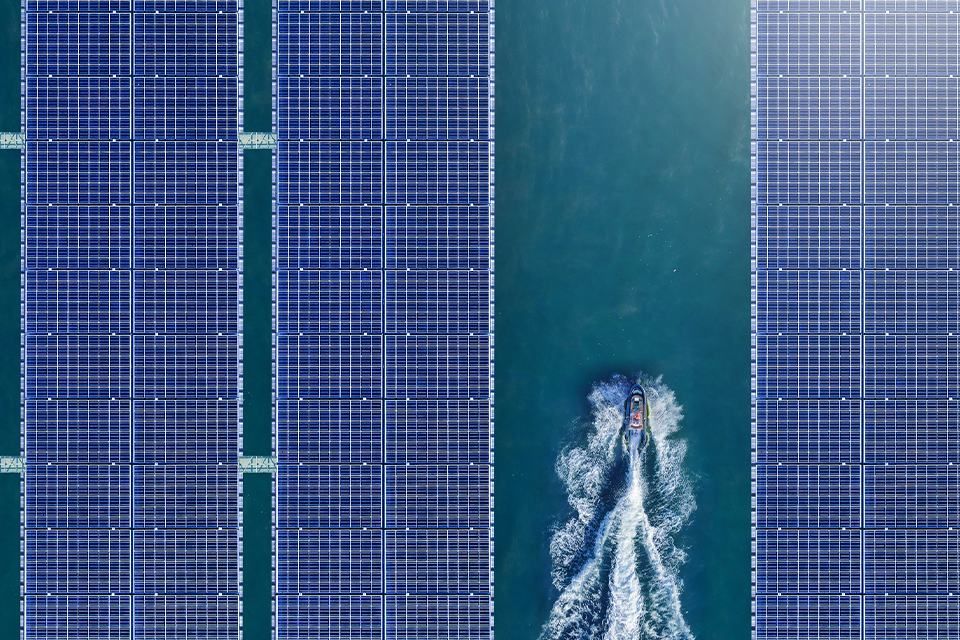Business sets the pace in a global order marked by risk and fragmentation
As governments grapple with regulation and national security priorities, the private sector has stepped into the breach

2023 was a year of change for White & Case, as I stepped into the role of Chair and my predecessor, Hugh Verrier, completed his successful 16-year tenure. The Firm began a new chapter well positioned for continued growth. This review highlights many of the achievements and pioneering initiatives that took place throughout the year.
As the world became increasingly fragmented, we focused on the global connections that matter to our clients. We collaborated across borders, providing integrated services and maintaining the strong personal and professional bonds that make a difference, particularly in uncertain times.
Our work on high-stakes deals, disputes and pro bono matters placed us at the center of industry trends related to energy transition, finance, technology and more. We contributed to the conversation on these issues, publishing insights that included a comprehensive report on the future of globalization. Our report, A world of clubs and fences: Changing regulation and the remaking of globalization, puts forward a new conceptual model to understand cross-border interconnectedness in a time of sweeping legal and regulatory changes.
We also increased our ability to serve clients, promoting 46 new partners and welcoming 36 lateral partners. We continued to find innovative solutions that enhance client services and foster efficiency. And as generative AI continues to make headlines, we developed tools that will enable us to embrace its possibilities, while carefully managing its risks.
Looking ahead, White & Case enters its next phase with a solid foundation and an ambitious growth plan that will keep us at the forefront of the rapidly changing legal industry. I look forward to what we and our clients will accomplish together in the coming years.
Guest speakers at Firm events share views on timely topics
As governments grapple with regulation and national security priorities, the private sector has stepped into the breach

Our learned behavior and ideas about work may keep us from operating at our best

By uniting industry participants who may seem to have divergent interests, the Global Battery Alliance is paving the way for a sustainable battery supply chain

Developments that reshaped the world
The war in Ukraine and high energy prices challenged energy transition timetables, but governments and investors were determined to stay the course

M&A and debt market activity declined in 2023, as high interest rates and macroeconomic dislocation saw increasingly cautious dealmakers and lenders put deployment on hold

Growth and investment in generative artificial intelligence (GenAI) lifted the technology sector after a slowdown in transaction activity throughout 2023, but regulatory challenges loomed large

The relatively free cross-border flow of goods, capital, information and people that have characterized globalization for decades is being replaced by regulatory "clubs" and "fences"

Highlights of our work in 2023
Our achievements position us for success
US$2.95 billion in revenue
2,559 total lawyers
1,291EMEA
998Americas
271Asia-Pacific
1,220US-qualified lawyers
550English-qualified lawyers

In markets around the world, White & Case earned many of the legal industry’s top accolades

White & Case is committed to fair and ethical operations that respect the interests of our stakeholders and recognize the importance of protecting our environment. Our Responsible Business Subcommittee leads environmental, social and governance (ESG) and sustainability efforts across our global operations.
As a signatory to the UN Global Compact, we affirm our commitment to doing business responsibly by aligning our operations with the Compact’s ten principles on human rights, labor, the environment and anti-corruption. Our most recent Communication on Progress outlines the steps we are taking to continue to embed these principles into our Firm’s operations.
Our latest Environmental Sustainability Report includes information on our sustainable operations, scope 1, 2 and 3 greenhouse gas emissions data, and our most recent Environmental Management Systems survey. Highlights from 2023 include:
Committed to advancing diversity and inclusion across the Firm
11 global affinity networks
Our 11 affinity networks foster a sense of community among the Firm’s Black, Asia-Pacific, Latinx/Hispanic, Middle Eastern and North African, minority ethnic and LGBTQ+ lawyers, business services professionals and their allies. Each network sets its own agenda, initiatives and goals, which are specific to the issues it considers most important. Affinity networks create and enhance awareness of these groups within the Firm and its larger culture, drive community and connection across our global offices, and support their members with career and professional development opportunities.
24 local women’s networks
Our 24 local women’s networks are active in 40 offices across the Americas, EMEA and Asia-Pacific. These networks foster professional development and mentoring activities. They also provide a forum for our lawyers and business services professionals to share perspectives and create programs to support and retain our women while fostering and promoting gender equity.
42% of the Firm’s global management
50% of the Executive Committee
21% of other leadership roles
36% of our 2023 global partner promotions
25% of global Partnership
43% of our lawyers
42% of our lawyers self-identify as of color
7% of our lawyers self-identify as LGBTQ+
4% of our lawyers self-identify with disabilities
28% of our partners self-identify as of color
3% of our partners self-identify as LGBTQ+
4% of our partners self-identify with disabilities
32% of our lawyers self-identify as of color
10% of our lawyers self-identify as LGBTQ+
4% of our lawyers self-identify with disabilities
13% of our partners self-identify as of color
5% of our partners self-identify as LGBTQ+
2% of our partners self-identify with disabilities
125nationalities
92languages spoken
Our commitment to diversity and inclusion is recognized by leading publications and alliance organizations
White & Case women gather to build connections and advance career opportunities

6 continents
44offices
30countries
An internal guide addresses 20 areas of legislation in four Asia-Pacific countries

A transformative technology enables new ways of working

Photo by © ASF - Architect Simone Forconi
iBridge, an interactive pedestrian bridge submitted for a design competition. Sensors on the floor of the bridge allow it to transform pedestrian and cycling traffic into usable energy.

The war in Ukraine and high energy prices challenged energy transition timetables, but governments and investors were determined to stay the course
Investment in energy transition reached a tipping point in 2023, as governments, companies and investors continued to deploy capital in decarbonization despite deteriorating macroeconomic conditions.
International Energy Agency (IEA) forecasts showed clean energy received 70 percent more investment than hydrocarbons in 2023, and for the first time ever, solar energy alone was on track to receive more aggregate investment than oil, equating to US$1 billion per day.
Mitigating the impact of climate change has remained the primary driver of this investment, but debate around energy transition has also expanded to encompass issues related to energy security and social justice.
While accelerating toward net-zero, policymakers have had to strike a delicate balance between fulfilling long-term emissions reduction commitments and meeting near-term energy demand. This has been particularly pressing in Europe, where countries dependent on Russian gas supplies have had to use more carbon-intensive fuels (such as coal) to fill energy supply gaps.
In 2023, White & Case worked closely with a broad group of businesses, investors and lenders to understand the complexities of energy transition projects and lay out roadmaps to achieve net-zero emissions by 2050. These are some of the key energy trends we observed throughout the year.
The war in Ukraine took a toll on energy transition timetables and contributed to rising energy costs.
Germany, for example, one of the biggest consumers of Russian gas, had to refire coal-powered plants to ensure energy security. Other countries, including the UK, Ireland, Italy, Spain, Poland and Switzerland, also lagged on energy transition timetables as gas supplies shrank, while the European Commission revised renewable energy targets.
Despite these immediate geopolitical obstacles, governments held firm on long-term net-zero pledges. In the US, the Inflation Reduction Act is delivering a package of incentives and tax credits for renewable energy projects worth more than US$400 billion. Germany still plans to phase out coal from its energy mix by 2038, and Denmark, Norway and Switzerland are all pushing to achieve 100 percent renewable production by 2030.
This ongoing commitment to net-zero in the policy arena has given companies and investors the confidence to continue investing in renewables and green energy.
The oil majors and national oil companies have ramped up M&A investment to diversify away from an overreliance on hydrocarbons. TotalEnergies, for example, has deployed billions of dollars in low-carbon energy capacity as part of a strategy to become a global leader in renewables and have 100 GWs of installed renewable capacity in place by 2030. Shell and BP, meanwhile, have invested heavily in renewable natural gas and green hydrogen. Shell acquired Danish biogas group Nature Energy in a US$2 billion deal in 2023, and BP supported the US$380 million Series C funding round in Electric Hydrogen, the green hydrogen industry’s first unicorn.
Other oil companies have used acquisitions to move into the electric vehicle (EV) and rare minerals markets. Chevron, for example, invested in EV high-speed charging stations company Electric Era Technologies, while ExxonMobil bought up US$100 million of drilling rights for lithium, a key material used in battery production.
As capital deployment into energy transition has accelerated, the range of renewable energy assets and carbon emissions reduction technologies receiving investment has expanded.
Governments and companies have recognized that there is no one solution for cutting emissions, and that all levers available must be pulled to meet net-zero targets.
This has seen governments open more opportunities for renewable energy development in areas that haven’t been exploited previously, as seen in the US where the federal government announced the sale of the first-ever offshore wind power lease in the Gulf of Mexico.
The US is also investing in new green energy generation options outside of the core wind and solar power markets. President Biden allocated US$21 billion of the 2023 budget to nuclear and hydrogen programs. This includes small modular reactors (SMRs), smaller nuclear power generation units that provide flexible energy supply and can be used in tandem with renewable energy to ensure stability and consistency of supply. Canada, the UK and France are also working on SMR and nuclear energy plans.
The focus on reducing emissions hasn’t been limited to energy generation, with substantial investment also flowing into capturing emissions from existing hydrocarbon energy sources.
The carbon capture, utilization and storage (CCUS) industry has been identified as a crucial piece of the energy transition puzzle, particularly in the US where the Inflation Reduction Act includes carbon oxide sequestration in its package of tax credits for clean energy solutions. CCUS is seen as an important short-term solution for ensuring energy security, while also reducing emissions, as the world gradually decouples energy systems and economies from hydrocarbons.
Major oil companies have been among the biggest investors in CCUS, with ExxonMobil joining forces with Mitsubishi Heavy Industries to deploy new carbon-capture technology across ExxonMobil’s emission reduction services for heavy-emitting industrial customers.
Photo by © Songphol Thesakit / GettyImages
Bird’s-eye view of solar panels floating in a dam, providing a source of renewable energy